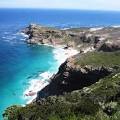
The Cape Provinces official name was: 'The Province of the Cape of Good Hope', but is often just called: 'The Cape.'
Cape Town started off as a small trading post run by the Dutch East India Company (VOC) from the Netherlands. Sailing ships on their way to India could stop to rest, do repairs and restock on supplies. This trading post was started by Jan van Riebeeck, who arrived in 1652. At first most of the Europeans worked for the DEIC, but later, more and more Europeans chose to come to the Cape to settle. They moved away from Cape Town and started farms and little towns to the north and east. The Europeans included Dutch, French and German people. There were also slaves in the Cape, brought especially from Malaysia to serve the people from the DEIC. When the Europeans came to the Cape, they came into contact with the native Khoikhoi people. The two groups had very different ways of life, and there were many clashes between them.
In 1806 Britain took over the Cape from the Dutch East India Company. This caused unhappiness among the farmers especially those on the eastern border of the Cape Colony. They were mostly Afrikaans, and did not want to be ruled by the British. The eastern border was very far from Cape Town, the capital. In those days, it was much more difficult to travel and it took a lot longer than today. This meant that the government did not have as much control over the places that were far away from Cape Town, so the farmers had to look after themselves and were basically free to do what they wanted. But when the British took over, they wanted more control over the eastern border.
When the British government of the Cape spread their control to the east, they also fought with the local Xhosa inhabitants. There were nine wars between the government and the Xhosa, called the frontier or border wars. The Dutch farmers also fought with the Xhosa over land. In the end, in about 1838, thousands of these farmers moved away from the Cape Colony to the north. This migration is called the Great Trek.
The Cape stayed a British colony until it became one of the four provinces of the Union of South Africa in 1910.
https://www.travelstart.co.za/blog/movies-filmed-in-south-africa/?amp=1
https://www.bona.co.za/lifestyle/top-5-must-do-activities-with-kids-in-cape-town/
http://www.southafrica-canada.ca/wp-content/uploads/2019/01/sa_women_day_2017.pdf
https://www.sahistory.org.za/archive/13-notable-women-cape-towns-history-6-august-2015
https://www.capetownmagazine.com/bucket-list
https://www.planetware.com/tourist-attractions-/western-cape-saf-wc-wc.htm
https://sporthelicopters.co.za/?gclid=EAIaIQobChMIqrunqpC1_QIVi7HtCh2vkQdoEAAYASAAEgLgqPD_BwE
https://www.thesouthafrican.com/travel/cape-town-tourists-what-to-do-what-to-see/